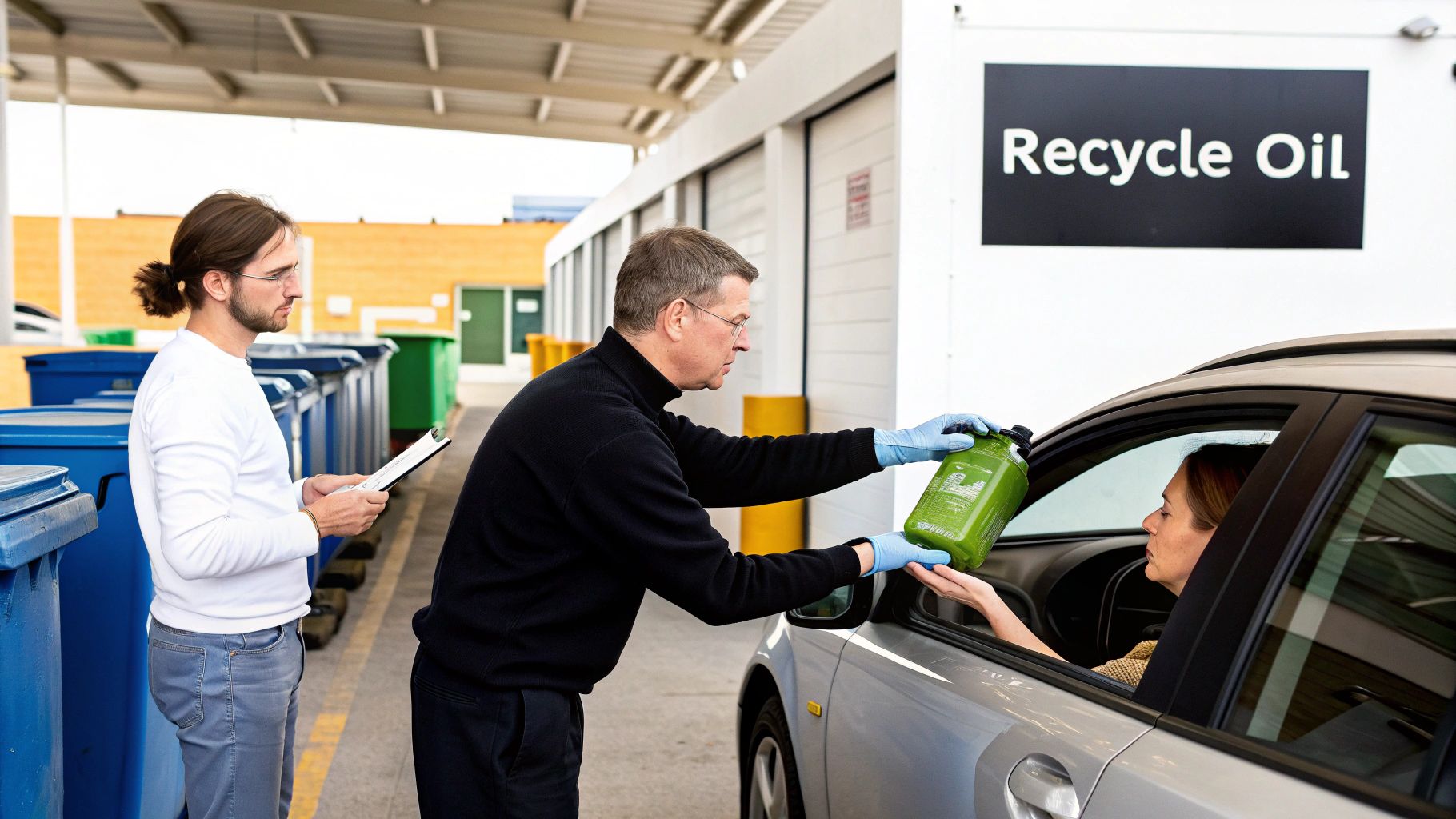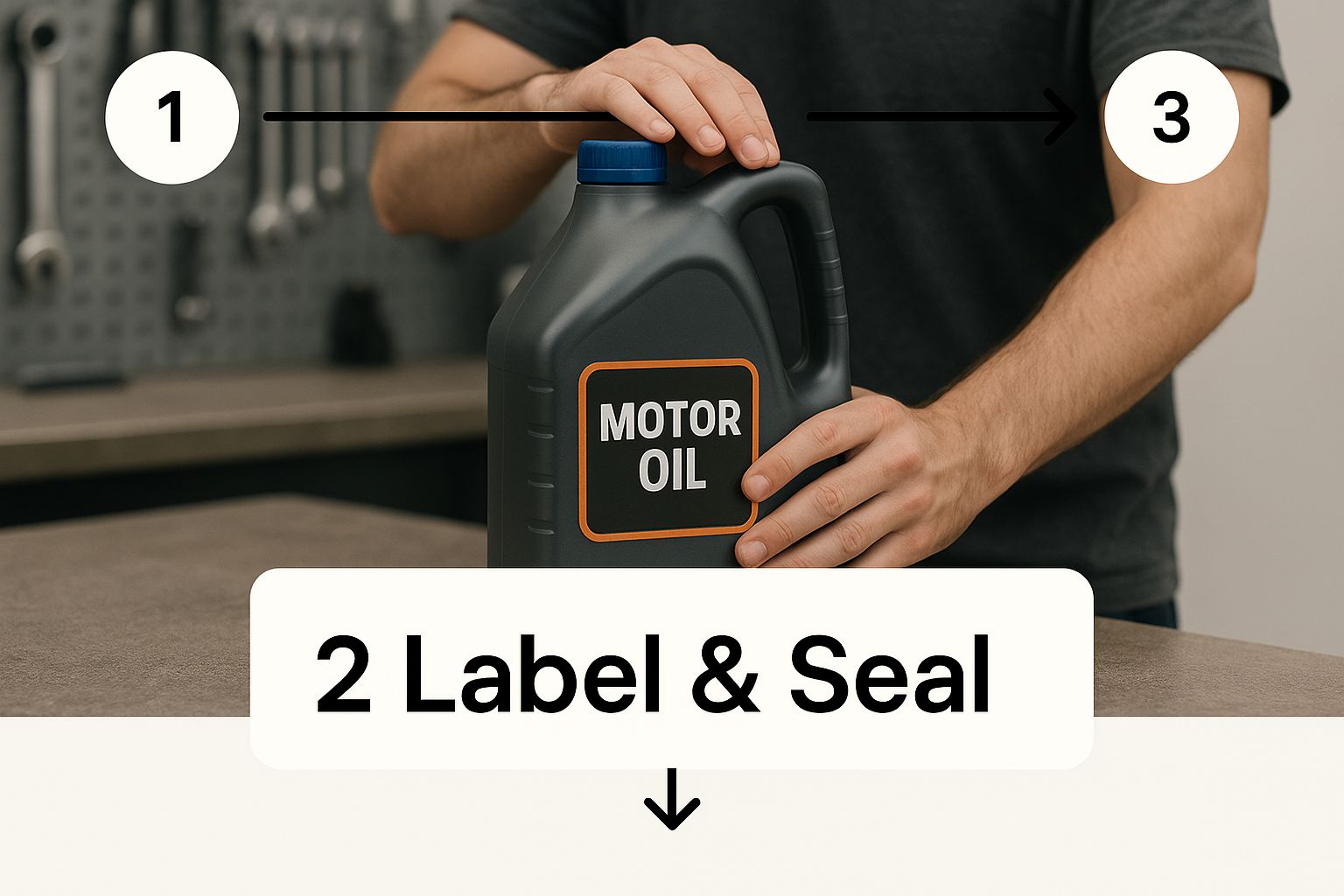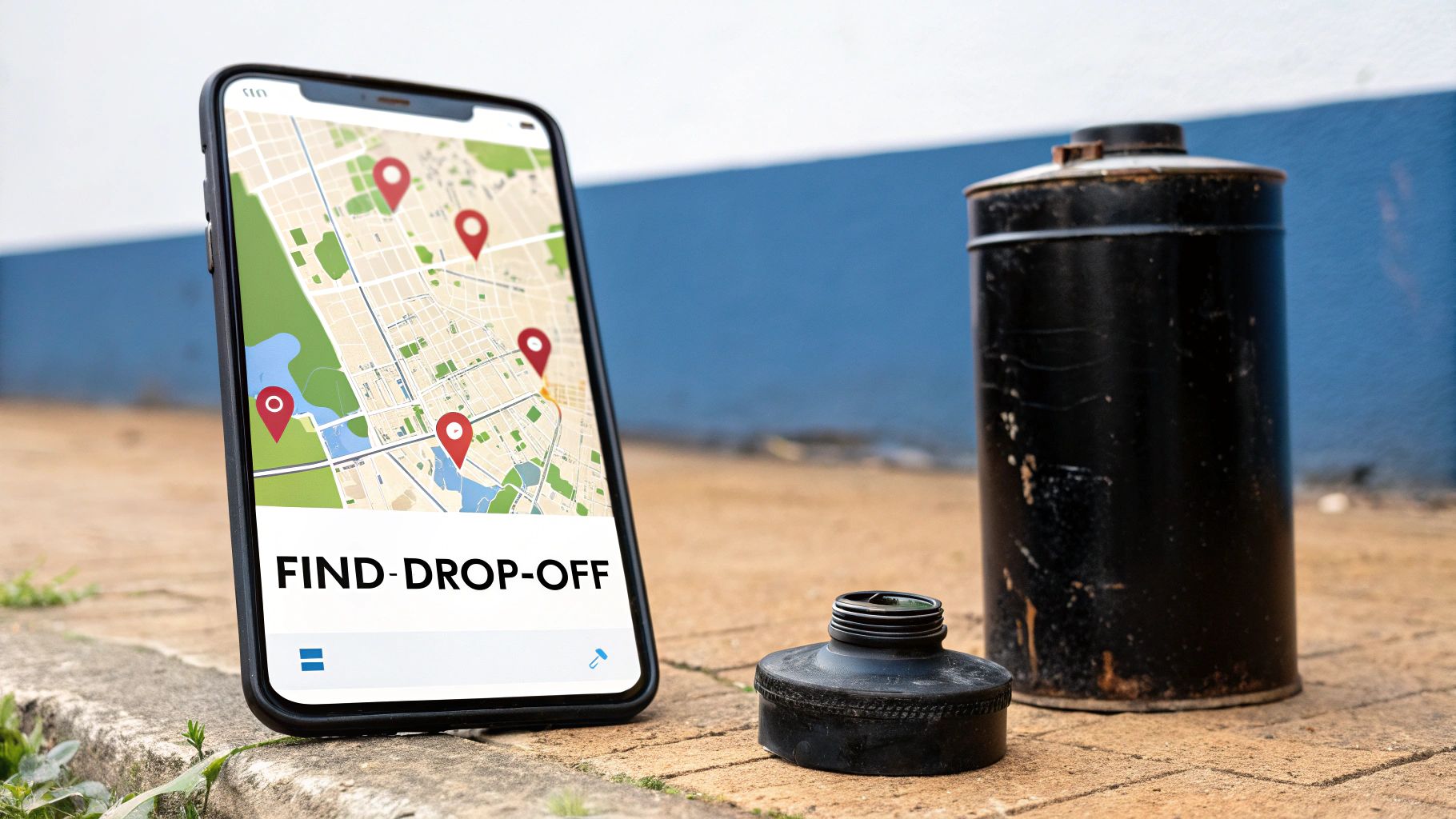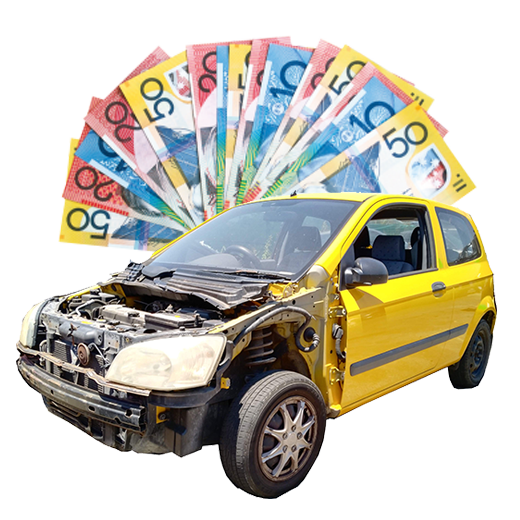So, you've just finished changing your car's oil, and now you're left with a container of the old stuff. What's next? The most important thing is getting it to a designated collection point. In Australia, you'll find these at local council recycling centres, certain auto part shops, and even some mechanic workshops, making it pretty easy to do the right thing.
Your Quick Guide to Motor Oil Disposal

If you're staring at that old container of used oil, don't sweat it. Getting rid of it the wrong way can cause serious environmental damage, but thankfully, there's a straightforward system in place to help you handle it responsibly. This guide will walk you through your options so you can get it sorted and move on with your day.
Why It's Easy to Recycle Used Oil in Australia
You might be surprised to learn there's a national program dedicated to this exact problem: the Product Stewardship for Oil (PSO) Scheme. This is a government-backed initiative that makes recycling your used oil both convenient and, in most cases, completely free for DIY mechanics. It’s what funds the entire network of collection points scattered across the country.
And it's working. The scheme has been a huge success, with nearly 60% of all used motor oil in Australia now being collected for recycling or reuse. This is the system that allows everyday people to simply drop off their used oil at service stations, workshops, or council facilities. If you're interested in the details, you can learn more about the impact of these waste oil programs.
Key Takeaway: Whatever you do, never pour used oil down a drain, on the ground, or into your regular rubbish bin. Just one litre of oil has the potential to contaminate a million litres of fresh water. Always, always take it to an authorised collection point.
Common Oil Disposal Locations at a Glance
Finding a drop-off point is usually just a quick search away. To give you a better idea of what to expect, here are the most common places you can take your used motor oil.
| Disposal Location | Typical Availability | Potential Cost |
|---|---|---|
| Council Recycling Centres | Widespread, but check opening hours. | Usually free for residents (up to 20L). |
| Auto Part Retailers | Select stores (e.g., Supercheap Auto, Repco). | Typically free for customers. |
| Mechanic Workshops | Many participate as collection points. | Often free, but call ahead to confirm. |
| Specialised Waste Facilities | For larger quantities or commercial use. | Costs may apply; check with the facility. |
This table should help you quickly identify the best option near you. A quick call or a look at your local council's website is the best way to confirm they'll accept your oil before you head over.
How to Prepare Used Oil for Recycling
Before you even think about where to drop off your used motor oil, you need to get it ready. A little bit of prep work goes a long way, and honestly, it’s not hard. Doing it right is the key to making sure the recycling centre will actually take it and can process it safely.
First things first, you need a solid container. The easiest option? Just pour the old oil back into the bottle the new stuff came in. It's built for the job, has a lid that seals tight, and you know it won't leak. If you’ve already tossed it, grab another clean, sturdy plastic container with a screw-top lid. An old laundry detergent bottle can work in a pinch.
Keep It Pure and Simple
This next part is crucial: don't mix anything else with the oil. It’s so tempting to just pour other leftover fluids into the same container, but resist the urge. Coolant, brake fluid, petrol, solvents – any of these can contaminate the whole batch. When that happens, what was a valuable resource becomes hazardous waste that's a real pain to dispose of.
To avoid this, always use a dedicated drain pan and funnel just for oil changes. Once it's all collected, screw that lid on as tight as you can. A loose cap is a recipe for a greasy, dangerous mess in the back of your car.
This infographic lays out the final, simple steps of sealing and labelling your container before you hit the road.

As you can see, taking a moment to label the container "Used Motor Oil" with a marker is a small detail that makes a huge difference for the people at the recycling facility.
Pro Tip: Never fill the container right to the brim. I always leave a few centimetres of empty space at the top. This gives the oil room to expand and stops it from leaking if the container gets tipped over. Trust me, it’s a simple trick that can save you from a massive cleanup job.
Following these practical steps makes the entire process a whole lot smoother. For a deeper dive into what happens next, check out some expert guides on used oil recycling. It’s a great way to see how your efforts are making a real difference.
Finding a Motor Oil Collection Point Near You

Alright, you've got your used oil safely bottled up and ready to go. So, where exactly do you take it? The good news is that you don't have to look far. Thanks to Australia's national recycling program, there's a whole network of places ready to take it off your hands. You just need to know where they are.
Your best bet is to start online. The Recycling Near You website, run by Planet Ark, is an absolute goldmine for this. Just pop in "used motor oil" and your postcode, and it'll pull up a map showing your closest drop-off points. It couldn't be easier.
Another great place to check is your local council's website. Councils are responsible for a lot of local waste management, so they’ll have the most current info. Look for pages on "hazardous waste," "chemical collection," or simply "oil recycling" to find a list of their facilities.
What Kind of Places Take Used Oil?
When you start searching, you'll see a few different types of collection points pop up. Knowing what they are can help you pick the most convenient spot.
- Council Transfer Stations & Recycling Centres: These are your most reliable bet. As official hubs for the national recycling scheme, they're fully equipped to handle things like oil safely and responsibly.
- Auto Parts Stores: Heaps of major retailers, like Supercheap Auto and Repco, have collection tanks for used oil. This is super handy, as you can drop off the old stuff right when you're buying new filters and oil for your next service.
- Local Mechanic Workshops: Many independent mechanics also act as community drop-off points. Just remember that they're running a business, so it's always polite to call first to make sure they're accepting oil from the public that day.
Pro Tip: I can't stress this enough – make a quick phone call before you head out. I once drove 30 minutes across town only to be told the collection tank was full and wouldn't be emptied until Monday. A two-minute call can save you a whole lot of hassle.
What to Expect When You Get There
Dropping off your oil is usually a straightforward affair. When you arrive, staff will point you toward a large collection tank, which often looks a bit like an igloo. You simply pour your oil in.
They'll also show you where to put your empty containers and old oil filters, as these get recycled separately. It’s a clean and simple process.
Finding a place to dispose of motor oil is far easier than most people realise. And if you're doing a bigger clear-out, learning more about finding an auto recycler near you in Australia can help you get rid of other old car parts the right way, too.
The Journey of Your Recycled Motor Oil
Ever wondered what actually happens after you’ve found a place to drop off your used motor oil? That old, grimy liquid doesn’t just disappear. It starts a remarkable journey, transforming from waste back into a valuable resource through a high-tech process called re-refining.
Once your oil is collected, it gets taken to a specialised processing facility. This isn't just a simple filtering job. It's a sophisticated purification process designed to strip out all the contaminants it picked up while lubricating your engine—things like water, dirt, tiny metal shavings, and burnt fuel particles.
From Dirty to Pure
The whole point is to get the oil back to its original, clean base form. It's a multi-stage affair that works something like this:
- First, dehydration gets rid of any water that's mixed in.
- Next, filtration removes all the solid gunk and sludge.
- Finally, vacuum distillation is the real magic. It separates the pure base oil from the leftover additives and other impurities.
What comes out the other end is a high-quality base oil, often so pure it's practically indistinguishable from virgin base oil made from crude. This re-refined oil is then ready for a new life, becoming the foundation for brand-new lubricants, hydraulic fluids, and various industrial oils.
This system is surprisingly effective. According to the Australian Mobile Oil Collection Industry, a massive 40 million litres of used oil were safely collected across the country in 2022. This process is a huge boost to Australia's circular economy goals, and you can discover more insights about the waste oil market to see the bigger picture.
Recycling makes a massive difference. Think about this: it takes about 160 litres of crude oil to produce just four litres of new lubricant. But with re-refining, it only takes four litres of used oil to create almost the same amount of high-quality product.
This journey shows how a simple action on your part can have a huge positive impact. It’s a key piece of a much larger puzzle that also includes recycling automotive parts for cash, all working together to conserve our precious resources and protect the environment.
Common Oil Disposal Mistakes to Steer Clear Of
Figuring out where to drop off your used oil is a great start, but how you handle it beforehand is just as crucial. The right way is simple, but a few common slip-ups can lead to your oil being turned away at the recycling centre, or worse, causing some serious environmental damage.
Let's get the biggest one out of the way: illegal dumping. It’s tempting to think a little bit won’t hurt, but the numbers are staggering. Just one litre of used motor oil can contaminate up to one million litres of fresh water. That’s enough to poison an entire ecosystem and threaten drinking water sources. Pouring it onto the ground is no better—the heavy metals and toxic gunk will seep into the soil and can eventually find their way into the groundwater.
And whatever you do, never toss it in your household rubbish bin. It's classified as hazardous waste for a reason. If that container leaks in the collection truck or at the tip, it creates a dangerous, polluting mess that someone else has to clean up.
The Contamination Trap
Here’s another mistake I see all the time: contamination. This is what happens when other fluids get mixed in with your used motor oil, and it’s the fastest way to make the whole lot unrecyclable. The facilities that re-refine oil use a very precise process that simply can't filter out other chemicals.
When you mix liquids, you’re creating a toxic sludge that recycling centres aren't set up to handle. You absolutely must keep your used oil separate from these fluids:
- Antifreeze or Coolant: These contain glycols that completely disrupt the oil recycling chemistry.
- Brake or Transmission Fluid: They have totally different chemical properties and can’t be processed together.
- Solvents, Petrol, or Paint Thinners: These are highly flammable and turn the mixture into a serious fire hazard.
The easiest way to avoid this is to have a dedicated drain pan and funnel just for your oil changes. It might seem harmless to top off a drum of oil with some old coolant to save a trip, but you’re turning a valuable resource into a hazardous waste headache.
A Cautionary Tale: A mate of mine once rocked up to his local council depot with a 10-litre drum of oil, proud he was doing the right thing. But they sent him packing. Turns out, he’d poured about a litre of old coolant into the drum to finish it off. The staff had to explain that the entire batch was now contaminated, and he'd have to take it to a specialised hazardous waste facility—a much bigger and more complicated ordeal.
Common Questions About Oil Disposal
Even when you've got a plan, a few questions can still pop up when you're dealing with old engine oil. Getting it right is important, so let's clear up some of the common queries from DIY mechanics around Australia.
Does It Cost Anything to Drop Off Old Motor Oil?
Good news—for most of us doing our own car maintenance, it's completely free. This is all thanks to the national Product Stewardship for Oil (PSO) Scheme, a government program that helps fund recycling services across the country.
You can typically drop off up to 20 litres at a time at no cost at your local council depot or participating auto shops like Supercheap Auto. It’s always a good idea to give them a quick ring beforehand, just to double-check their hours and make sure they've got space.
What About the Empty Bottle and the Old Filter?
Don't just chuck them in your household bin! The places that take your used oil will almost always take the containers and filters too.
- Empty Containers: Once drained, the plastic bottles are perfect for recycling.
- Used Oil Filters: These are full of valuable steel. They get crushed to squeeze out every last drop of oil before the metal is recovered.
When you get to the drop-off site, just ask the staff where everything goes. They'll have separate bins for each item to make sure nothing gets contaminated and everything can be properly recycled.
One quick tip: Never, ever mix other fluids like coolant, brake fluid, or petrol in with your used engine oil. It contaminates the whole batch and can make it impossible to recycle. These other liquids need to be disposed of separately, as they're also hazardous.
Your local council’s website is the best place to find out how to handle other automotive fluids safely.
If you've got more than just used oil to get rid of—like an entire unwanted car—Auto Removal Adelaide can help sort you out. We pay cash for cars on the spot and offer free scrap car removal throughout Adelaide. You can get a quick quote and clear out that driveway space by visiting us at https://autoremovaladelaide.com.au.


